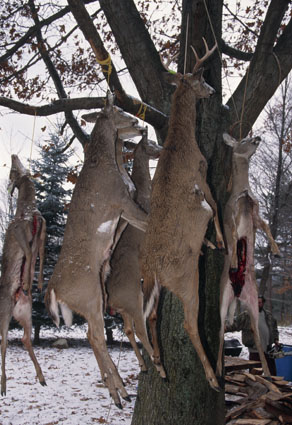 Rick Streeter is an award-winning taxidermist with a penchant for detail. “Even if you book a fully guided trip, you can’t expect the outfitter or guide to double as an expert taxidermist, too,” Streeter says. Here are steps that you can take to help ensure a great trophy later on.
Rick Streeter is an award-winning taxidermist with a penchant for detail. “Even if you book a fully guided trip, you can’t expect the outfitter or guide to double as an expert taxidermist, too,” Streeter says. Here are steps that you can take to help ensure a great trophy later on.
Find A Local Taxidermist
“I tell my clients to find a local taxidermist, and ask him how he likes his hides,” Streeter says. “He is more likely to give you solid advice concerning trophy care. I just had a new client come into my studio requesting a full body mount on a beautiful black bear. Unfortunately his guide cut the bear’s rear legs off, and there is nothing I can do to repair the damage.”
Take Your Time, Do A Good Job
What you do in the field before it reaches a taxidermist can mean the difference between a life-like mount for your living room wall, or a bad mount destined for the back of the garage.
Cut Enough Cape
“The first mistake hunters make,” says Streeter, “occurs when they cape the animal. For a full shoulder mount, you must cut the hide off from well behind the front leg. Starting at mid body is never a bad idea; too much cape is always preferable to not enough. Use a big knife, like one with an eight-inch curved blade, and try to leave as much muscle tissue on the carcass as possible. Otherwise you will be spending extra hours later scraping the meat and fat off the hide.
“The most common error we see here at the studio however is a cape with four eye holes. This occurs when you cut into the membrane located right above the eyeball. To make sure this doesn’t happen to you, stick your finger into the animal’s eye socket and feel for the knife’s blade. The presence of your finger against the blade will hopefully guide you around the socket and stop you from cutting through the upper eyelid.
Cut At Least A Half-Inch Of Lip
“The second most common error occurs when you slice the lip leaving most of it attached to the skull and not the hide,” Streeter says. “The trick here is to insert your finger inside the animal’s mouth, and find the knife’s blade. Then cut inward and back towards the base of the jaw so that you do not cut across the lips. Your taxidermist will need at least a half-inch of lip all the way around in order to give you a quality realistic looking mount.
“Finally, when you get to the nose, stick your finger inside one nostril at a time, (you can use a pair of rubber gloves here if you are a bit squeamish) and feel for the blade. You want to leave the animal’s nose on the hide, not the skull.
“If you are going to be in the field for an extended period of time, and there is no freezer available, you must also turn the ears and split the lips. The lips are easy, but the ears are a bit tricky. I recommend my clients practice on does or yearling bucks before planning a do-it-yourself hunt.”
No Cooler? Remove The Skull
If you are back in the boonies, and do not have access to a freezer or cooler, then you are going to have to remove the skull yourself, but be careful. The hairs here are quite short in this area, making it difficult for a taxidermist to repair the damage if you cut a hole or lop off an ear by mistake. Use a knife with a replaceable scalpel blade available through Havalon (www.havalon.com). Use a larger knife only for scraping excess meat off the hide.
Pack The Cape In A Burlap Bag…
How should you transport the cape? Whenever possible pack the cape in a burlap bag. This will allow air to circulate around the hide. Generally, however airlines what the hide in a plastic bag so that it doesn’t leak blood into the hold of the aircraft. But the second you disembark get your hide out of that plastic bag and put into a burlap bag.
…Or Use An Ice Chest
“You can also elect to transport your cape in an ice chest,” says Streeter. “Put the ice in a plastic bag, or keep a block of ice in the bottom of the chest with a piece of burlap used to separate the hide from the melting ice and the bacteria in it.
If you don’t what to chance skinning out the head yourself, it is best to freeze the cape and head. The cold temperatures will slow down the growth of bacteria, and the deeper the freeze, the slower the growth.
“Do not salt and then freeze the cape however,” warns Streeter. “It will actually rot in the freezer, although at a slow rate. Like ice on a winter road, the hide will remain damp even though the air temperature in the freezer is well below freezing. If you do elect to freeze the cape, put it in a plastic bag. This is the only time, other than traveling on a commercial airplane when it is mandatory, that I would recommend the use of a plastic bag. You don’t want a warm hide to sit in a pool of water where bacteria are thriving.






